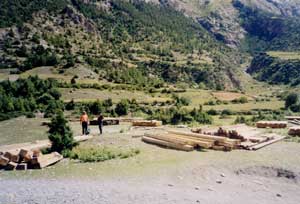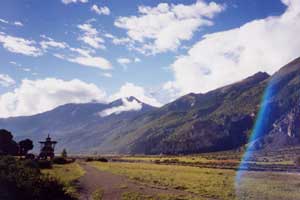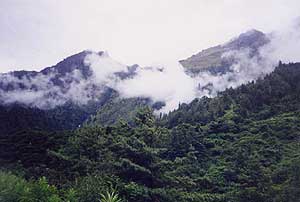 Local entrepreneurs in Manang could never have imagined their luck would run out so fast. Until just last year, this remote district bounded by Thorung-La, Tibet and the high Himalaya was one of the most trekked areas of Nepal. And almost every resident of every village along the trekking route was building a lodge or expanding their teahouse, in anticipation of even more visitors. Many natives of Manang settled in Kathmandu, Pokhara and overseas were even moving back, sensing better business in the boom, and building hotels and homes.
Local entrepreneurs in Manang could never have imagined their luck would run out so fast. Until just last year, this remote district bounded by Thorung-La, Tibet and the high Himalaya was one of the most trekked areas of Nepal. And almost every resident of every village along the trekking route was building a lodge or expanding their teahouse, in anticipation of even more visitors. Many natives of Manang settled in Kathmandu, Pokhara and overseas were even moving back, sensing better business in the boom, and building hotels and homes. But Manang has seen trekkers drop by 40 percent this year. And that isn't the only loss the area has had to bear-in the last decade this trans-Himalayan valley has lost over 10 percent of its lush forest cover, in large part due to the wave of construction to be ready for what locals hoped would be increasing numbers of tourists. Annapurna Conservation Area Project (ACAP) officials, as well as some locals, are worried that unless they can enforce uniform regulations on felling, or at least run awareness programs about safe logging practices, Manang will rapidly lose its richest natural resource.
ACAP officials say the mushrooming of new lodges and teahouses in Manang and other areas in the Annapurna region last year was unprecedented. "Never before have so many structures been built in these areas in one year," an ACAP employee told us. There are no official records to quantify the increase, but locals say that every village on the trekking route saw at least half-a-dozen new lodges built, and there wasn't any tourist accommodation that did not go in for a renovation or expansion. Given the cost of transporting other construction materials to this remote part of the Annapurnas, most people build structures of wood and stone along traditional lines, paying Rs 50-100 for a tree, and Rs 5 for a seven foot-long wooden plank.
 Pasang Lama, chairman of the Conservation Area Management Committee (CAMC) at Chame, Manang district's headquarters, says the construction boom is also in part due to the return of locals formerly living abroad and in different parts of Nepal. "After they saw no more prospects in business overseas, locals who'd migrated elsewhere are returning to their homes, some of them lured by the prospect of a tourism boom," explains Lama. The local population of Manang has now reached over 10,000, an increase of almost 50 percent in the last decade. "Each new family in the region exerts extra pressure on the natural resources such as timber for the many new houses that will be built.
Pasang Lama, chairman of the Conservation Area Management Committee (CAMC) at Chame, Manang district's headquarters, says the construction boom is also in part due to the return of locals formerly living abroad and in different parts of Nepal. "After they saw no more prospects in business overseas, locals who'd migrated elsewhere are returning to their homes, some of them lured by the prospect of a tourism boom," explains Lama. The local population of Manang has now reached over 10,000, an increase of almost 50 percent in the last decade. "Each new family in the region exerts extra pressure on the natural resources such as timber for the many new houses that will be built. The problem is that in the district, especially in Upper Manang, logging has never been a cause for concern or debate. ACAP has formed a Conservation Area Management Committee in every village under its purview, but says it is difficult to implement new logging-control mechanisms in this area, where traditional practices are still dominant. In many villages, the responsibility for managing the entire common forest lies with a single person, contradicting every conservation tenet of ACAP.
"Outside" administration has virtually no chance of influencing the local community, we were told. "That is why the organisation finds it hard to implement their rules and regulations. There are many instances of bad decisions made by us," said a young resident of the Manang Village Development Committee, who did not want to be named. "There are still no Forest User Groups in the upper belt of Manang, like there are in the lower part," the ACAP official told us. "The fate of the forests depends on the whims of the person who has been entrusted to look after them." In keeping with tradition, permission to fell trees can still be obtained by making an offering of chhang and a khada to the "authority". The District Forest Office has no say, and logging is on the rise.
 The lack of uniform laws shows in the forest-some areas have what appears to be healthy tree cover, other hillsides are denuded and bare. Take the case of Pisang village, where the forest is thicker than that around other villages in Upper Manang. So far. The village administrators have already given out some pockets of the forest on contract to neighbouring villages. Manang village itself is increasingly dependent on this contract for its timber needs these days.
The lack of uniform laws shows in the forest-some areas have what appears to be healthy tree cover, other hillsides are denuded and bare. Take the case of Pisang village, where the forest is thicker than that around other villages in Upper Manang. So far. The village administrators have already given out some pockets of the forest on contract to neighbouring villages. Manang village itself is increasingly dependent on this contract for its timber needs these days. Even smaller plants are feeling the ill-effects of mis-managed logging. After the trees are felled, the logs, instead of being carried away, are simply rolled downhill, smothering the undergrowth. The Manang forests contain a significant portion of the over 1,200 species of plants found in ACAP, including 40 varieties of orchids and 10 types of rhododendron. The forests are also home to many endangered animal species, such as the red panda and possibly the snow leopard. Our informant in Manang who spoke on condition of anonymity, said that even if control over felling were to follow the old norms, outside agencies could do a lot better in terms of raising awareness about better logging practices. "When the laziness to carry a single log results in the death of so many smaller plants, the least we could get is proper education on these issues."
Executives of the King Mahendra Trust for Nature Conservation, which manages ACAP, say that while things are bad in Manang, the loss of forest cover isn't as swift or extensive as it would be if northern Manang's border with Tibet were easier to cross. Both ACAP and police officials at Chame investigated the possibility of smuggling into Tibet when they heard about the growing illegal timber for salt bartering in the Langtang and Manaslu areas, which have relatively easier access to Tibet. A similar, but far worse, situation exists in Humla, where illegally logged timber is traded in Tibet via Taklakot for food and alcohol. (See "Nepali timber to Tibet," #17.) Ganga Bahadur Thapa, executive officer of the KMNTC insists that all trees felled in Manang are for domestic consumption.
 Unfortunately, that, combined with the in slump tourism doesn't mean that the logging will slow down anytime soon. People are still building, hoping for better times. "Everyone is keen on running a hotel these days," says Lama. Even before last year's flurry of building activity, upper Manang had 700 beds to cater to a maximum of 200 tourists at any given time. There are now more than 100 lodges and teahouses in Manang district, which gets around 12,000 trekkers annually. In Manang village alone, there are 20 lodges, some boasting as many as 50 rooms, often with a deluxe room option. Narendra Lama, the officer in charge of ACAP's Manang office, says "Everyone with a little bit of money feels they must invest in the hotel industry." Ironically, assessments of the tourism industry in Manang say that only 10 percent of the population benefits directly from the construction of new tourist accommodation.
Unfortunately, that, combined with the in slump tourism doesn't mean that the logging will slow down anytime soon. People are still building, hoping for better times. "Everyone is keen on running a hotel these days," says Lama. Even before last year's flurry of building activity, upper Manang had 700 beds to cater to a maximum of 200 tourists at any given time. There are now more than 100 lodges and teahouses in Manang district, which gets around 12,000 trekkers annually. In Manang village alone, there are 20 lodges, some boasting as many as 50 rooms, often with a deluxe room option. Narendra Lama, the officer in charge of ACAP's Manang office, says "Everyone with a little bit of money feels they must invest in the hotel industry." Ironically, assessments of the tourism industry in Manang say that only 10 percent of the population benefits directly from the construction of new tourist accommodation. The CAMC is trying to regulate logging, issuing permits in some places, and trying to work with indigenous ways of authorising felling in others, such as fixing the price of timber and trees. Such control mechanism haven't been very effective yet, however. "That's why we are trying to come up with new, strict rules," says CAMC's Lama. If the new regulation can be implemented, no logging will be allowed for the construction of hotels and lodges in Manang VDC for the next 10 years. "We will implement similar ideas in other villages gradually," Lama says hopefully.
Any regulation, no matter how well thought-out and inclusive, will find it tough going against the traditional ways in which natural resources have been used in this tight-knit community. In the meantime, conservationists suggest that the ACAP needs to start evaluating the impact of its work. They fear that Manang may prove to be an unexceptional case in the Annapurna, just more dramatic. "It is high time they did an impact study," says Dr Chandra Gurung, Country Director of the World Wildife Fund- Nepal. "ACAP has been working in the area for 15 years, it is time they assessed the state of the natural resources now, and compared it with what it was back then."


